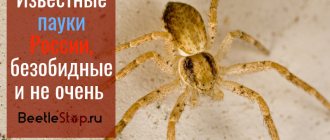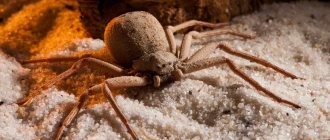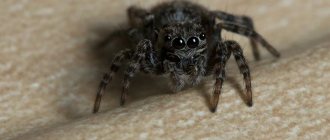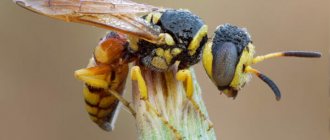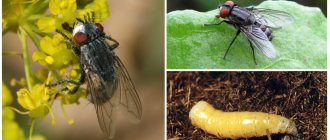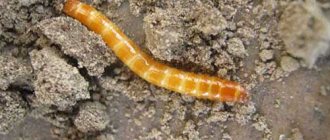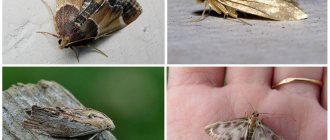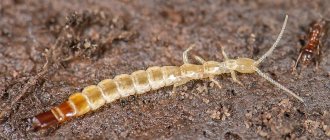17 August46602various animalskarakurtspidersdangerous animals
Karakurt is a spider from the black widow family. There are many different dangerous animals on our planet. Everyone knows that a polar bear or a crocodile poses a huge danger to humans. But these predators are huge and will not go unnoticed. You should know that creatures that are difficult to notice can pose a much greater danger, because they are no larger in size than a five-ruble coin. One of these is the karakurt spider. In this article you will find a description and photo of the karakurt spider, and also learn a lot of new and interesting things about this spider from the genus of black widows.
Origin of the species and description
Photo: Karakurt spider
Karakurt belongs to the arthropod arachnids, is a representative of the order of spiders, the family of web spiders, classified in the genus black widows, a species of karakurt.
The exact period of origin of the ancient ancestors of modern spiders - arachnids - is quite difficult to establish, since they do not have a shell, and the chitinous layer is destroyed quite quickly. However, scientists and researchers still manage to occasionally discover such finds. Most often, the remains of the ancient ancestors of modern spiders were preserved in amber. The discovered findings made it possible not only to recreate the external image of the ancient ancestor of arthropods, but also to obtain entire pictures in the form of a frozen mating process, or weaving a web.
Video: Karakurt spider
Ancient amber finds allowed scientists to conclude that spiders already existed approximately 300 - 330 million years ago. On the territory of modern China, scientists have discovered fossils of ancient arthropods. In these finds, the shapes and body structure of insects were very clearly visible. It is in this area that the remains of the most ancient spider, Attercopus fimbriunguis, were discovered. The ancient representative of arthropods had small sizes, not exceeding five millimeters, and a long tail, which was about a fifth of the length of the body.
It was used by insects to secrete sticky threads. They were involuntarily released and used by ancient spiders to line burrows, wrap cocoons, and attract individuals of the opposite sex. Ancient arthropods of that time had a slightly different body structure. In addition to having a tail, which is absent in modern insects, they had an incompletely fused head and abdomen.
Presumably the first spiders appeared on Gondwana. With the formation of Pangea, they rapidly began to multiply and inhabited almost all parts of the Earth. Subsequent ice ages somewhat reduced the habitat areas of arachnids. These insects were characterized by fairly rapid spread and modification. At the beginning of the Carboniferous, they tended to lose the division of the cephalothorax and abdomen. Scientists say that the remains of spiders, which date back to 150-180 million years, allow us to conclude that the arthropods of that time were practically no different from modern spiders.
Structure of karakurt
The structure of the karakurt
The structure of the karakurt is practically no different from the structure of other spiders. Its body is divided into two sections: the anterior section of the body, with four pairs of eyes, is covered with a hard chitinous shield. The second section is the abdomen, which is covered with an elastic membrane. The arachnoid glands are located in this part of the body. On the head of the body there are two pairs of modified limbs - chelicerae and pedipalps, behind which are walking legs. Spiders have eight of them.
Chelicerae consist of one limb, at the end of which there is a claw into which the poison gland opens. They are designed to grab and hold prey, as well as protect against enemies.
Interesting: Birds are the lords of the air: list of interesting representatives, photos and videos
The pedipalps are similar to the legs, but shorter. They are an organ of touch and usually do not take part in movement. In sexually mature males. They are slightly modified.
Appearance and features
Photo: Karakurt spider in Russia
These species of spiders have very pronounced sexual dimorphism. The female is significantly larger than the males. The average body size of one female individual is approximately 2-2.5 centimeters, male - 0.7-0.9 centimeters. The spider is quite easy to distinguish from other arthropods. The body and long limbs are black with red spots on the abdomen. In some arthropods they may have a white edge. They often disappear after reaching puberty, leaving the body a solid black color.
The arthropod has four pairs of long limbs located on both sides of the body. The longest are the first and last pairs. The two pairs of limbs that are located in the middle are shorter. They are covered with special hairs that allow them to easily approach a victim caught in the viscous spider threads. Spiders have a special gland that produces powerful poison. It is designed to paralyze and kill insects. Also, with its help, karakurts kill small steppe rodents, whose burrows they subsequently occupy.
Newborn small spiders are almost transparent. However, after the first molt, the body acquires a darker shade, and whitish circles appear on the abdomen, arranged in three rows. After each subsequent molt, the insect’s body becomes darker and the circles become red. The more often a spider molts, the faster it matures. The frequency and multiplicity of molting depends on a sufficient amount of food supply. Male individuals most often, after the sixth or seventh molt, stop feeding heavily and begin searching for a female to continue the race.
Interesting fact: Surprisingly, Karakurts have blue blood. This is due to the fact that it is not the scarlet hemoglobin that is responsible for the color of the blood, but hemocyanin, which gives the blood a blue tint.
When and how does the karakurt bite?
The first karakurt bites occur in May - early June. However, in 2007, on March 5, the press reported the first and only case of a winter spider bite. Spiders usually sleep in winter, but the warm winter, according to experts, has disrupted their biological clock. The most frequent and dangerous bites of karakurt are observed in July and August. From September to the end of October, when it gets colder, karakurts die en masse.
All adult individuals die, only the spiderlings spend the winter in cocoons, from which they emerge in the summer. In recent years, there has been a movement of karakurt into an area of relatively dense human habitation. These are barns, abandoned courtyard buildings, woodpiles, rural latrines (cases of being bitten in the buttocks are known). It is possible for karakurt to penetrate into housing during prolonged heavy rains, flooding the spider’s habitats.
The natural enemies of the species are sphex wasps, which paralyze the karakurt with an injection of a poisonous sting, as well as insects of the group of “riders”, which lay their eggs in the karakurt’s cocoon and turn the entire clutch of karakurt into food for the ripening of their offspring. For these insects, karakurt is good prey.
Clinic of defeat.
For diagnosis, a karakurt bite is extremely difficult. The fact is that a person does not feel pain. The location of the lesion is determined by two small red spots, slight hyperemia, swelling and numbness.
General symptoms develop later than the injury - within 15 minutes to 6 hours. The shorter the time period between the bite and the development of general symptoms, the more severe the manifestations of intoxication, when burning pain from the bite site spreads throughout the body.
The patient is very restless and has a fear of death. Then the pain moves to the muscles of the body (abdomen and chest). Breathing becomes difficult. In severe cases of poisoning, respiratory distress can result in pulmonary edema and cardiac arrest.
Pain is accompanied by muscle tension and fascicular muscle twitching. The intoxication process involves the facial muscles with a grimace of pain and fear, blepharoconjunctivitis and lacrimation are observed.
Symptoms of karakurt poisoning last on average 24-48 hours, and sometimes much longer. Poisoning in severe cases can lead to death within 1-2 days. Death from a karakurt bite is most likely in persons (children and adults) with severe concomitant diseases or in those who were admitted to the hospital late.
The number of deaths ranges from 4 to 6% of the total number of bites.
Recovery occurs gradually - after two to three weeks. It depends on the amount of poison that enters the body. Neurological consequences (asthenia, weakness) can last from one to two months.
Upon admission to a medical institution, a large number of diagnostic errors are observed. Pain in various parts of the body is so severe that doctors mistakenly classify it as acute abdomen or myocardial infarction. This, of course, affects the outcome of poisoning.
How to protect yourself from a karakurt bite
The most reliable defense against the deadly poison of karakurt is not to do anything stupid while relaxing in nature. To prevent contact with karakurt, you must follow certain rules:
1. For parking, you should choose areas that are unsuitable for karakurt life (the absence of a large number of rodent holes, cobwebs in soil depressions and on vegetation).
2. There is no need to walk barefoot in places where karakurts may live, and not only them.
3. You cannot sleep in the steppe on bare ground; you must use a tarpaulin or air mattresses, which are reliable protection against spider bites at night.
4. When collecting hay, straw, firewood, clearing forest belts and wastelands, it is recommended to use gloves and protective clothing, tuck pants into socks and boots.
5. You should not turn over stones or feel your way along rocky slopes at night.
6. It is not recommended to leave tents open all day. Before getting into bed or sleeping bag, you need to shake them thoroughly. Don't forget about shoes!
7. Most bites are provoked by the victims themselves. Summer residents and homeowners struggle with wild grasses on the territory of households and adjacent areas, so karakurts and tarantulas often take over vegetable gardens. Some people take off their shoes in the evening and leave them in the aisles. Spiders mistake abandoned shoes for a welcome mink - and the morning can be fatal.
Where does the karakurt spider live?
Photo: Karakurt spider
The natural regions in which the karakurt feels most comfortable are steppes, forest-steppes, and semi-desert areas. Often this type of arthropod can be found near ravines, artificial hills, arable lands, in desert, abandoned regions, etc.
Karakurts prefer to settle in regions with a warm, dry climate. Due to climate warming, the habitat of spiders has expanded significantly. They have become quite common in Crimea, Sevastopol, even in some regions of the capital of the Russian Federation.
Geographical regions of karakurt habitat:
- forest-steppe territories of the Republic of Kazakhstan;
- steppes of the Astrakhan region;
- territory of Central Asia;
- Afghanistan;
- Iran;
- coast of the Yenisei;
- Mediterranean coast;
- Southern Europe;
- North America;
- Crimea;
- southern part of Russia.
The burrows of small rodents are chosen as a place for permanent residence, and they are killed using strong poison. I can live in dry ditches, wall crevices, secluded corners. They especially love various construction sites and abandoned buildings with many secluded and inaccessible places.
Climate change may cause migration. Spiders are afraid of cold and dampness, and therefore, when cold weather sets in, they leave their shelters in search of warmer places. In dense thickets or in a bare area under the direct scorching sun, it is unlikely that you will find this dangerous insect. The lair of the insidious black widow is entwined with a dense web.
Now you know where the karakurt spider lives, let's now see what the poisonous spider feeds on.
What does the karakurt spider eat?
Photo: Poisonous karakurt spider
The main diet of poisonous spiders is insects. To catch them, spiders weave webs, which they hang on tree branches, in the grass, etc. The web of females is denser than that of males. It is noteworthy that spider webs are not very viscous, and therefore the victim who gets caught in them will no longer be able to get out. Having caught their prey, the spiders first immobilize it with poison, and then suck out the liquid contents of the body.
What serves as the food supply for karakurt:
- flies;
- horseflies;
- locusts;
- grasshoppers;
- beetles;
- mosquitoes;
- caterpillars;
- bloodworms;
- other arthropod species;
- snakes;
- lizards.
In rare cases, small invertebrate animals that get caught in the web and cannot get out of it can serve as a food source.
It is worth noting that the venom of these spiders can kill even animals such as a cow, horse or camel. Only hedgehogs and dogs can easily tolerate it. For humans, insect venom poses a great danger. It is considered to be most toxic during marital relations. It should be noted that even the venom of a small spider is enough to kill an adult, strong man. The venom has a pronounced paralytic effect, which instantly immobilizes the spider's victim.
Reproduction
Karakurt
The female karakurt, before mating, leaves the nest and is in constant motion, leaving behind a special double thread, along which the male finds her.
The mating process is preceded by fairly long dances. The male twitches his abdomen and animatedly moves his pedipalps.
Interesting: The largest beetles in the world - list, sizes, names, where they are found, photos and videos
The spider approaches its partner with the greatest caution, but females only show aggression when they are not ready. Females do not attack partners, but favorably accept courtship.
Competition between males during mating season is common. One female gathers up to ten contenders around her, fighting among themselves. The strongest and most agile one drives away other males and proceeds to mating games.
During mating games, the female karakurt enters a state of catalepsy and remains motionless for quite a long time. In this state, she is not dangerous for the male.
Afterwards, the female suddenly comes out of her stupor and inflicts several blows on her partner with her chelicerae, after which the partner turns into a small lump. The female gets rid of the deceased partner and accepts the courtship of the next contender. Despite the creepy appearance, this feature of the behavior of karakurts has a positive meaning for the species as a whole. Males are capable of mating only once in their lives. Left alive, they would compete with males that had not yet copulated, thereby complicating the reproduction of the species. Read more in our article: Why does a black widow eat her husband?
Features of character and lifestyle
Photo: Karakurt spider in Crimea
This type of poisonous arthropod loves dry, hot weather. That is why their habitat region is strictly limited to warm, southern countries. Recently, cases of appearance and spread on the territory of the Russian Federation have become more frequent. Here they pose a serious danger to the population, since people do not always have information about their proximity to dangerous insects. Often, when cold weather sets in, they can penetrate directly into a person’s home.
They also cannot tolerate extreme heat and heat, and therefore, after the onset of extreme heat in some countries, they migrate to more northern regions. Spiders make their lair in inaccessible places - burrows of small rodents, crevices of concrete walls, low thickets of vegetation, and other places. The spider received its second nickname “black widow” because the female eats the male after mating. Moreover, this happens with each subsequent partner.
Interesting fact: By eating their partners, females receive the necessary amount of protein, which future offspring will later need.
Scientists claim that even if, in rare exceptions, males manage to avoid the sad fate of being eaten, they still die, as they lose all interest in food and instinctively stop eating it. Karakurts tend to lead a rather hidden lifestyle. They can attack or attack only when they sense danger.
Social structure and reproduction
Photo: Karakurt spider in the Rostov region
This type of arthropod is characterized by a high degree of fertility. Every 9-12 years there is an incredibly high birth rate of these dangerous insects. The mating season begins at the height of the summer season. Before the start of the breeding period, the female looks for a secluded place. The male lays out a web that contains special pheramones that attract individuals of the opposite sex. Seeing his partner appear, the male performs something similar to a dance. He sways from side to side, moves his limbs.
After mating, the female mercilessly eats her partner and begins to look for a suitable place to lay eggs. Once a place is chosen, she carefully weaves it with a web, on which she lays out the cocoons. After the mission is completed, the female dies. The cocoon reliably protects the eggs from damage and cold. If strong winds blow in the fall, they tear off the cocoons and can carry them far into the steppe, spreading the spiders’ habitat.
From the moment the eggs are laid, small insects appear after about two weeks. However, they are in no hurry to leave the cocoon, as they are waiting for the onset of spring and warming. During the first time they are in the cocoon, they exist due to the accumulated nutritional components. Subsequently, they begin to eat each other, as a result of which we can say with confidence that the strongest individuals emerge from the cocoon in the spring.
The growth and development of spiders continues throughout the spring and summer period. During this period, each individual goes through 5 to 10 molts. The exact amount depends on the amount of food and gender. Females shed more than males.
Interesting fact: The body of the spider is covered with a chitinous shell, which limits the growth and development of the arthropod. During the molting process, the karakurt sheds its shell, replacing it with a new one, larger than the old one in size.
What kind of life does a karakurt lead?
Most often, the karakurt makes a nest at the base of grass stems or directly on the ground, where it weaves spherical cocoons for eggs and places a trapping net nearby. Catching nets and cocoons are made of very strong, tightly stretched web with a stretch coefficient of up to 30%.
Karakurt builds cocoons in July - August. After 5-7 days, spiderlings appear in the cocoon, but they emerge from there only next year at an air temperature of 30° (15-20° degrees in the shade).
Karakurts are not aggressive towards humans; when they meet, they leave or pretend to be dead. A spider can bite at the moment when the trapping nets are disturbed, or it is pressed against the human body. This most often occurs when spending the night in natural conditions, much less often during the day when collecting wildflowers, hay or straw, or lying on the ground.
The toxicity of karakurt venom depends on many factors: season, age and gender of the spider. Mature females are especially poisonous in comparison with young ones, in which red dots on their black abdomen are surrounded by a white border.
Natural enemies of the karakurt spider
Photo: Poisonous karakurt spider
Despite the fact that karakurts are considered one of the most dangerous creatures on earth, they have enemies in their natural habitat. The greatest danger to them is posed by herd ungulates, since in huge numbers they trample not only the arthropods themselves, but also their cocoons with eggs.
In addition to ungulates, the enemies of spiders are sphex wasps. They attack arthropods in a similar way. Wasps have a special gland that produces poison, which they inject into spiders, immobilizing them. After this, the insects quietly eat the black widow.
Another enemy of poisonous and dangerous arthropods are riders. They lay eggs in arthropod cocoons. Subsequently, the emerging larvae eat the small spiderlings. It should be noted that there are other enemies that are also capable of eating karakurts in large quantities. These are hedgehogs. They are absolutely not afraid of attacks from these insects, since they are reliably protected by their shell with needles.
Spiders are also theoretically eaten by some species of other spiders or arthropods. However, they must be very dexterous and agile in order to attack the black widow before she can inject her poison. However, this happens extremely rarely, since karakurts are very fast.
In some regions, the reduction in the number of karakurts is caused by human activities associated with the destruction of rodents, as well as the use of insecticides of chemical origin.
Bites
Having given an idea of the black widow as an animal, we move on to the main part of our story - karakurt bites. It is immediately necessary to identify two main positions related to this:
- A black widow's bite can be fatal.
- Spiders are not the first to attack humans.
Symptoms
To begin with, let’s outline the symptoms of a karakurt bite, which appear very quickly.
- Within 10-15 minutes, all the muscles of the body begin to ache, as happens with the flu or other colds. The muscles that hurt the most are the chest, abdominals, and lumbar region.
- In addition, the heart rate increases, shortness of breath appears, dizziness, tremors of the limbs and even priapism in men.
- After this, general weakness of the body sets in, it seems that the limbs do not obey the person, and vomiting appears.
- Next, nervous exhaustion occurs in the human body and depression may occur.
- A person’s consciousness becomes cloudy, and he ceases to be aware of reality and even recognize people close to him.
If the antidote is not administered in time, physical death may occur.
However, it is not at all necessary that all karakurt bites are fatal to humans. Firstly, people with increased immunity will tolerate a bite much easier than those weakened by disease, or those who have an increased allergic reaction to poisons. Secondly, the highest concentration of poison is observed in black widows during the mating season and after laying eggs; in other seasons, bites are less terrible.
Reference! Karakurt males are not able to bite through human skin, therefore they are not dangerous for people and most animals.
What to do after a bite
The most effective way after a bite is to immediately cauterize the wound. This allows you to destroy the poison, preventing it from spreading through the blood throughout the body. The fact is that the female bites through the skin only half a millimeter, and for some time the poison concentrates almost on the surface.
You can cauterize the bite wound directly with the head of a match, or by heating any metal object at hand over a fire:
- blade of knife;
- cutlery;
- house or car key;
- metal comb.
Attention! Cauterization should be done within the first 10 (!) minutes after the bite. After this time, the poison will circulate throughout the body.
Everyone knows what to do next - immediately contact the nearest medical facility, which will provide the required assistance. In regions where the black widow is common, there is almost always the necessary serum, which is designed to neutralize the poison.
In extreme cases, when the necessary remedy is not available, it turns out that an intravenous injection of ordinary potassium permanganate at a concentration of 2-4 percent or magnesium sulfate at a concentration of 10-15 percent can alleviate the patient’s plight.
After medical procedures, the patient should be given plenty of fluids to remove poison from the body and a hot bath to reduce pain. It is also a good idea to take painkillers and sleeping pills, because healthy sleep is of great benefit to the body weakened by the bite.
Karakurt animal bites
Different animals react differently to black widow bites. Horses and camels suffer the most from it, including death, which in some regions is a real scourge for agriculture. Also, many rodents die from karakurt poison.
At the same time, dogs, hedgehogs, amphibians and reptiles are practically insensitive to karakurt poison.
Now it's time to watch a video about the black widow. Watch the report from America, filmed by our former compatriot.
